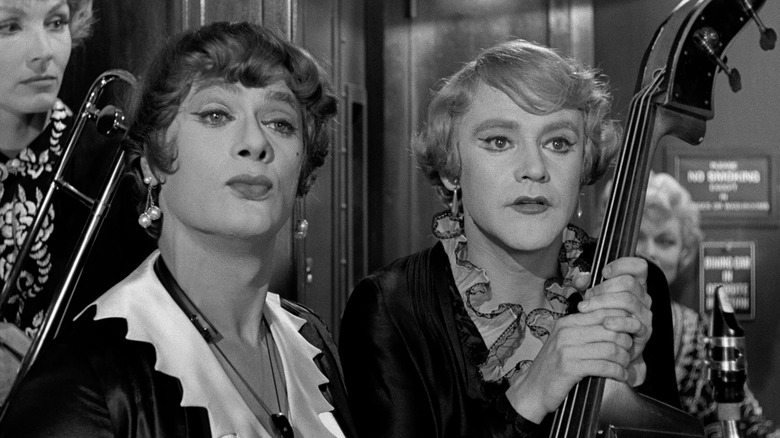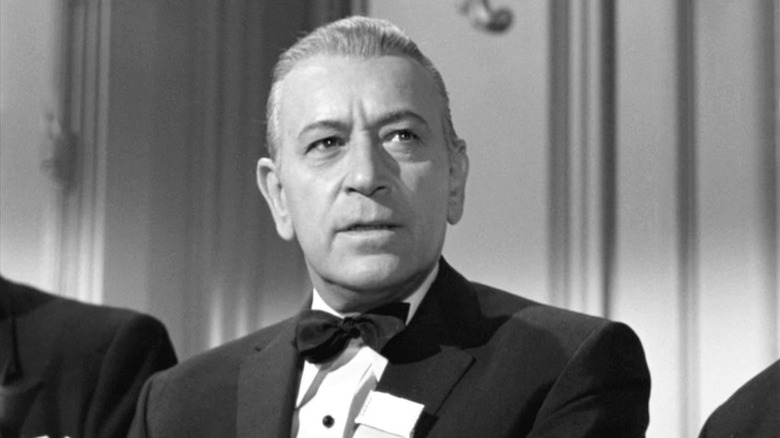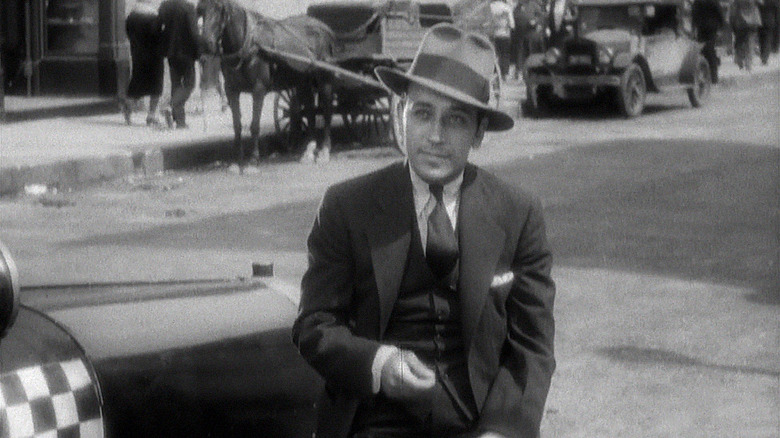The Scarface Tribute You Probably Missed In Some Like It Hot
Billy Wilder's 1959 film "Some Like It Hot" is about musicians in disguise, gangsters, and music, but really it's all about sex. In the film, Tony Curtis and Jack Lemmon play a pair of down-on-their-luck musicians – of the saxophone and upright bass – who witness a gangland slaying and have to go on the run. They hide out – in drag – within an all-female traveling music troupe. The bulk of the film is about how Curtis and Lemmon narrowly evading detection, while Curtis also disguises himself as a Cary Grant-like millionaire to romance the troupe's lead attraction Sugar Kane played by the human tidal wave of glitter, Marilyn Monroe.
While many of the film's gags stem from the awkward adolescent fantasies of being a straight man hiding out with a group of pent-up young women, there is no small amount of queer subtext — and just plain text — in "Some Like It Hot." Indeed, the film was made outside the auspices of the then-eroding Hays Code, and the film's success was a large part of the argument for scrapping the Code entirely (via NPR).
The bending of gender norms was played for farce in 1959, but Wilder and co-screenwriter I.A.L. Diamond knew what they were doing with sex and sexuality. They were playing with flirtation and arousal, yes, but also gender lines and sexuality. At one point in the film, when Jack Lemmon has been getting too flirty with the women in the troupe, Curtis has to remind his friend that he's a girl, he's a girl, he's a girl. Later, when Lemmon has found himself on the affectionate end of a genuine millionaire (played by Joe E. Brown), and Lemmon finds himself eager to accept said affection, Curtis has to remind him he's a boy, he's a boy, he's a boy. Despite these reminders, Lemmon accepts a marriage proposal from Brown. "Why would a guy marry a guy?" Curtis asks. "Security!" Lemmon shoots back.
Same-sex couples wouldn't be allowed to legally marry in any of the United States for another 34 years, and would not be federal mandate until 2015. Speaking of the law, "Some Like It Hot" also features a clever nod to "Scarface," one of the most famous organized crime movies in cinema history. And no, we're not talking about the one with Al Pacino.
George Raft
The antagonist of "Some Like It Hot" is the Chicago gangster "Spats" Columbo, so named for his favorite piece of clothing. Indeed, he loves his spats so much that he insist others wash their hands before buttoning them on. "Spats" is an archetypal character, played with all the necessary heft by George Raft, and whose Chicago origins indicated that he was clearly modeled after Al Capone. However, "Spats" was just the latest in a very long line of movie gangsters that had been a fashionable character type throughout the 1930s.
Indeed, one of the more famous gangster films of the 1930s was Howard Hawks' "Scarface," a violent film (for the time) about an amoral Italian gangster named Antonio "Tony" Comonte, played by the excellent Paul Muni and also inspired by Al Capone. "Scarface" is about the rise of a rough-hewn Chicago criminal who embraces increasingly violent means — inspired symbolically by a billboard declaring "The World is Yours!" — to seize power throughout the city. In order to do this, Comonte declares war on the city's other gang leaders, and aspires to kill them off. In a notable scene, and one that kicks off the war to come, Comonte sends one of his lieutenants to murder the leader of Chicago's north side in a flower shop. The lieutenant, a suave, tough, coin-flipping thug named Guido, is played by none other than George Raft.
There is a scene in "Some Like It Hot" — made 27 years later, mind you — that pays homage to Raft's famous role in "Scarface." When "Spats" enters a hotel, one of his own lieutenants can be seen flipping a coin very much in the same way Raft did in "Scarface." In a cute reference, Raft snatches the coin out of the air, looks his thug in the eye and asks, "Where did you pick up that cheap trick?" Raft then, without breaking eye contact, shoves the coin in the man's pocket. Wilder and Raft were clearly having a little fun, simultaneously mocking a visual cliché about gangsters — that Raft started — and allowing Raft to remind his underling, and the audience, that he is the "real" gangster in the room.
George Raft's Erotic Power
George Raft's career is deep and extensive, and stretches back, believe it or not, into a career of exotic dancing. In the 1920s, Raft made a living as a taxi dancer, which is a dance partner-for-hire at public clubs; you may have heard the phrase "my dance card is full" in movies, which is an allusion to taxi dancers who would have a roster of pre-planned partners written on a ticket. He also delved into the 1920s New York nightclub scene, dancing with Rudolph Valentino (before he acted in movies), and eventually dancing in night clubs in Paris and London as well. His most notable nightclub gig was at The 300 Club, a notable speakeasy in New York run by Texas Guinan (and read up on Guinan; she is amazing). Raft was part of the nightly show, a reportedly bawdy affair.
In a 2000 biography on Raft written by Lewis Yablonsky, Raft admitted that he could have been "the first X-Rated dancer." He continued, "I was very erotic. I used to caress myself as I danced. I never felt I was a great dancer. I was more of a stylist, unique. I was never a Fred Astaire or a Gene Kelly, but I was sensuous."
Perhaps that sensuality is what assured Raft would have such a long career. Raft continued to act and dance until his death in 1980 at the age of 79, with his final film being "The Man With Bogart's Face." The next time you see a gangster flipping a coin, hopefully you'll think of George Raft.


